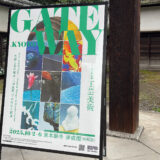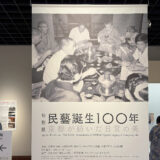In Japanese Kogei art, gold has been used in various works using various techniques.
Many of the works on exhibit at Kogei Art KYOTO also use gold.
Gold has played a significant role in Japan’s history, deeply influencing its art, craft, and culture. The allure of this precious metal, with its rich luster and enduring value, has been interwoven into Japanese society for centuries.
Let’s explore how gold has shaped Japan’s artistic and cultural heritage and its development of gold mining.
Ancient Beginnings
Japan’s fascination with gold dates back to ancient times. Gold was first introduced to Japan from the Asian mainland around the 5th century. The Japanese quickly embraced this precious metal, incorporating it into their religious and cultural practices. Temples and shrines began to feature gold leaf in their decoration, symbolizing purity and divinity.
The Nara and Heian Periods
Gold became more prevalent during the Nara (710-794) and Heian (794-1185) periods. The Golden Hall of Chūson-ji Temple, built in the 12th century, is a remarkable example. This hall is entirely covered in gold leaf, reflecting the sophisticated techniques developed by Japanese artisans. Gold was also used to create Buddhist statues and religious artifacts, showcasing the intricate craftsmanship of the time.

The Muromachi and Azuchi-Momoyama Periods
The Muromachi (1336-1573) and Azuchi-Momoyama (1573-1600) periods saw a flourishing use of gold in various art forms. The Kinkaku-ji, or the Golden Pavilion in Kyoto, constructed in the late 14th century, remains one of the most iconic structures. Its top two floors are covered in gold leaf, symbolizing the pinnacle of luxurious design.
In addition to architecture, gold was extensively used in the art of makie (sprinkled picture), a lacquerware technique in which gold and silver powder are sprinkled to create intricate designs. This period also saw the development of kinky (gold leaf), which was used to adorn screens, sliding doors, and other decorative objects.

The Edo Period
The Edo period (1603-1868) was marked by economic stability and cultural prosperity, leading to an increased demand for gold in art and decoration. Gold leaf production peaked, and cities like Kanazawa became famous for their gold leaf craftsmanship. This period also saw the rise of netsuke (miniature sculptures), often gilded with gold and used as toggles for traditional garments.
Koban and Oban Coins
During the Edo period, gold played a crucial role in Japan’s monetary system through the circulation of Koban and Oban coins. The koban, an oval-shaped gold coin, was a staple of the Edo economy. It represented a significant value and was widely used for large transactions. The oban, a larger and more valuable version of the koban, was often used for ceremonial purposes and large-scale trade. Both coins were highly valued not only for their gold content but also for their craftsmanship and decorative designs.

Gold vs. Silver
Gold and silver were significant in Japan’s economy, but their uses and values differed. Gold was more stable and used for high-value transactions, while silver, primarily in the form of ichibu-gin and nibuban-gin coins, was used for everyday trade and smaller transactions. Silver was more abundant than gold and fluctuated more in value, leading to its role in regular commerce and trade with foreign merchants.
Gold Mining in Japan
Japan’s gold mining history is equally fascinating and crucial to understanding the nation’s economic and cultural development.
Early Mining
The earliest records of gold mining in Japan date back to the Nara period, when gold deposits were discovered in the Tohoku region. The Kinzan (gold mountain) in the province of Mutsu was one of the earliest known gold mines.
The Sado Gold Mine
The most significant gold mine in Japan’s history is the Sado Gold Mine, located on Sado Island in the Sea of Japan. Discovered in 1601, the mine played a pivotal role during the Edo period, producing large quantities of gold and silver, significantly contributing to the Tokugawa shogunate’s wealth. At its peak, the Sado Gold Mine employed thousands of workers and was considered one of the world’s leading gold production sites.

Modern Mining
In the modern era, gold mining saw advancements with the introduction of Western mining techniques during the Meiji Restoration (1868-1912). This period saw increased exploration and development of gold mines across Japan, enhancing the country’s gold production capabilities.
Modern Era
In modern times, the use of gold continues to be an essential aspect of Japanese culture. Traditional crafts such as kintsugi (golden joinery), where broken pottery is repaired using lacquer mixed with powdered gold, reflect the philosophy of finding beauty in imperfection. Gold is also a staple in contemporary art and jewelry, symbolizing tradition and innovation.
Cultural Significance
Gold’s cultural significance in Japan extends beyond its aesthetic appeal. It represents wealth, power, and divine connection. The meticulous craftsmanship involved in working with gold also reflects the Japanese values of precision, patience, and respect for materials.
Conclusion
The historical connection between Japan and gold is a testament to the country’s rich artistic heritage. From ancient religious artifacts to modern art, gold symbolizes beauty, craftsmanship, and cultural identity. As Japan continues to evolve, its timeless relationship with gold remains a shining example of the nation’s dedication to excellence in art and craft.







